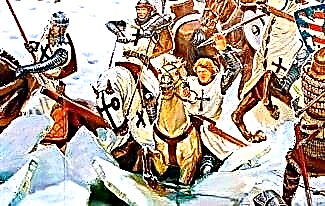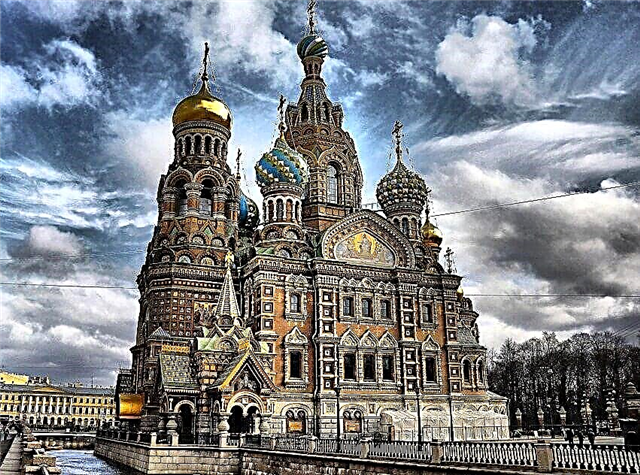Tehran conference - the first in the years of World War II (1939-1945) conference of the “big three” - the leaders of 3 states: Joseph Stalin (USSR), Franklin Delano Roosevelt (USA) and Winston Churchill (Great Britain), held in Tehran from November 28 to December 1, 1943
In the secret correspondence of the heads of 3 countries, the conference code name was used - "Eureka".

Objectives of the conference
By the end of 1943, the turning point in the war in favor of the anti-Hitler coalition became obvious to everyone. Consequently, the conference was necessary to develop an effective strategy for the destruction of the Third Reich and its allies. On it, important decisions were made regarding both war and the establishment of peace:
- The allies opened the 2nd front in France;
- Raising the topic of granting independence to Iran;
- Start of consideration of the Polish question;
- The beginning of the war between the USSR and Japan was agreed upon after the fall of Germany;
- The boundaries of the post-war world order are outlined;
- Unity of views has been achieved regarding the establishment of peace and security throughout the planet.
Opening of the "second front"
The main issue was the opening of a second front in Western Europe. Each side tried to find its own benefits, promoting and insisting on its own terms. This led to lengthy discussions that were unsuccessful.
Seeing the hopelessness of the situation at one of the regular meetings, Stalin got up from his chair and, turning to Voroshilov and Molotov, angrily said: “We have too many things to do at home to waste time here. Nothing good, as I see it, is turning out. There was a tense moment.
As a result, Churchill, not wishing to disrupt the conference, agreed to a compromise. It is worth noting that at the Tehran conference many issues related to post-war problems were considered.
The question of Germany
The USA called for the fragmentation of Germany, while the USSR insisted on maintaining unity. In turn, Britain called for the creation of the Danube Federation, in which some German territories were to be.
As a result, the leaders of the three countries could not come to a common opinion on this issue. Later this topic was raised in the London Commission, where representatives of each of the 3 countries were invited.
Polish question
Poland's claims in the western regions of Belarus and Ukraine were satisfied at the expense of Germany. As a border in the east, it was proposed to draw a conditional line - the Curzon line. It is important to note that the Soviet Union received land in northern East Prussia, including Konigsberg (now Kaliningrad), as an indemnity.
Post-war world structure
One of the key issues at the Tehran conference, regarding the accession of lands, concerned the Baltic states. Stalin insisted that Lithuania, Latvia and Estonia become part of the USSR.
At the same time, Roosevelt and Churchill called for the accession process to take place in accordance with a plebiscite (referendum).
According to experts, the passive position of the heads of the United States and Great Britain actually approved the entry of the Baltic countries into the USSR. That is, on the one hand, they did not recognize this entry, but on the other, they did not oppose it.

Security issues in the post-war world
As a result of constructive discussions between the leaders of the Big Three regarding security around the world, the United States put forward a proposal to create an international organization based on the principles of the United Nations.
At the same time, the sphere of interests of this organization should not have included military issues. Thus, it differed from the League of Nations that preceded it and had to consist of 3 bodies:
- A common body composed of all members of the United Nations, which will only make recommendations and hold meetings in various places where each state can express its own opinion.
- The executive committee is represented by the USSR, the USA, Britain, China, 2 European countries, one Latin American country, one Middle East country and one of the British dominions. Such a committee would have to deal with non-military issues.
- The police committee in the faces of the USSR, the USA, Britain and China, which will have to monitor the preservation of peace, preventing new aggression from Germany and Japan.
Stalin and Churchill had their own views on this issue. The Soviet leader believed that it is better to form 2 organizations (one for Europe, the other for the Far East or the world).
In turn, the British Prime Minister wanted to create 3 organizations - European, Far Eastern and American. Later, Stalin was not against the existence of the only world organization that monitors order on the planet. As a result, at the Tehran conference, the presidents failed to reach any compromise.
Assassination attempt on the leaders of the Big Three
Having learned about the upcoming Tehran conference, the German leadership planned to eliminate its main participants. This operation was codenamed "Long Jump".
Its author was the famous saboteur Otto Skorzeny, who at one time freed Mussolini from captivity, and also conducted a number of other successful operations. Skorzeny later admits that it was he who was entrusted with the elimination of Stalin, Churchill and Roosevelt.
Thanks to the high-class actions of Soviet and British intelligence officers, the leaders of the anti-Hitler coalition managed to find out about the impending assassination attempt on them.
All Nazi radio communications were decoded. Upon learning of the failure, the Germans were forced to admit defeat.
Several documentaries and feature films were shot about this assassination attempt, including the film "Tehran-43". Alain Delon played one of the main roles in this tape.
Photo of the Tehran Conference














